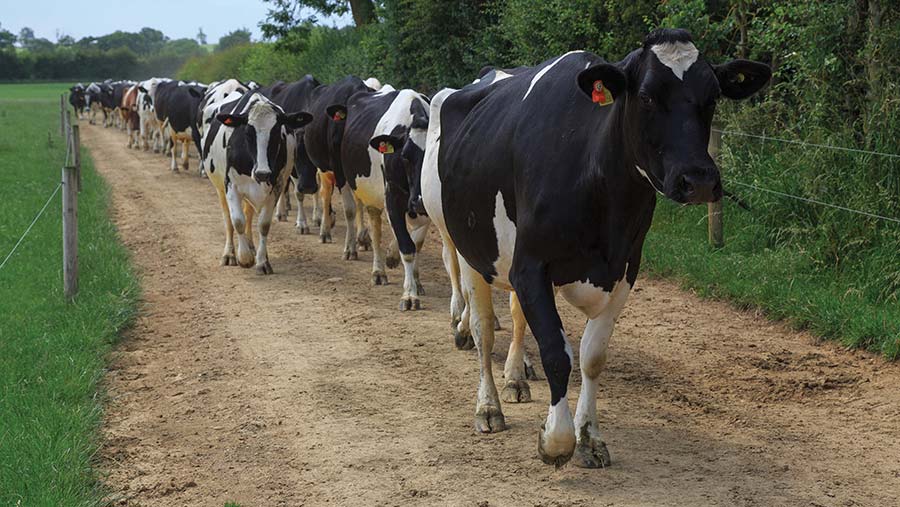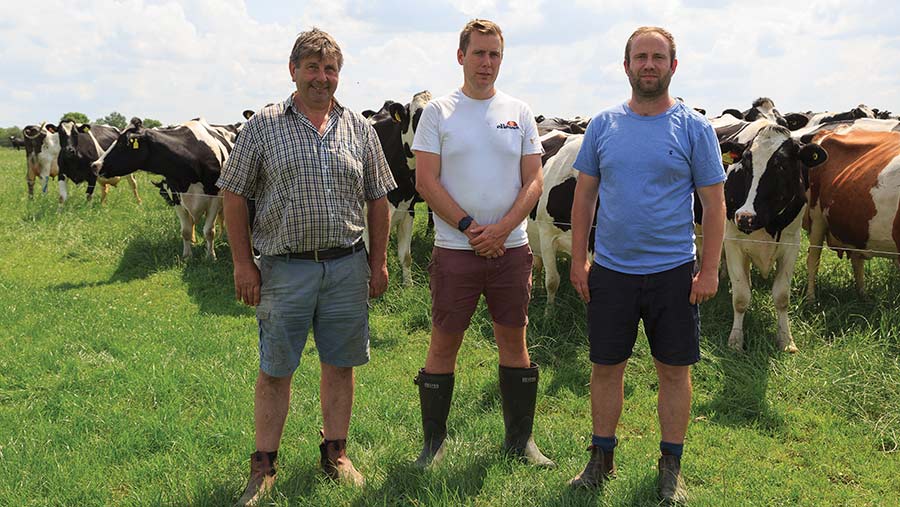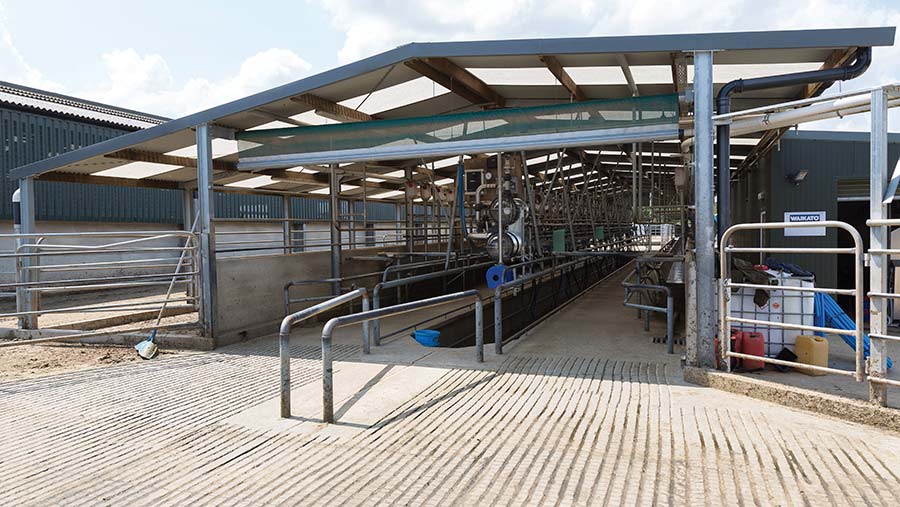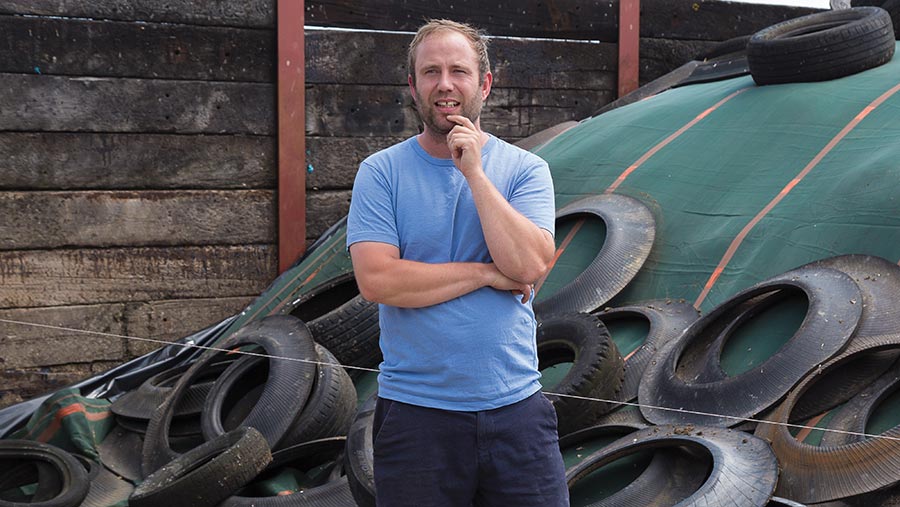How brothers secured future with second autumn-block herd
 © MAG/Judith Tooth
© MAG/Judith Tooth A second dairy unit set up on neighbouring arable land has given two brothers a long-term future on their Leicestershire family farm
Martin Wade and his sons, George and Ben, ran at Honeypot Farm, a 350-cow dairy unit between Market Harborough and Lutterworth.
They worked well together and both sons were keen to stay on the farm, but with a village-centre site, there were limits to growth.
They were exploring options when a neighbouring arable farm came on the market.
This presented the family with a golden opportunity to set up a second dairy unit, and their landlord and retired business partner, Cliff Garner, was prepared to buy it, funded in part by the sale of some land for development.
See also: Silage calculations save on feed for autumn block-calver
Farm facts: Oak Tree Farm
- 350 Holstein Friesian cows with Irish genetics
- Autumn block-calving
- 94ha (232-acre) grazing block
- Self-feed silage
- Average yield nearly 8,000 litres, at 3.66% protein and 4.4% butterfat
- Milk supplied on cheesemaking contract to Long Clawson Dairy
- Belgian Blue, Angus and Wagyu used for beef crosses
“These opportunities tend to come to those who farm well,” says Max Sealy of The Farm Business Consultancy, who helped the family develop their ideas into a viable plan.
“With a blank canvas on a greenfield site, there were no constraints. But as a 20-30-year investment, succession needed to be considered.”
As an AHDB Strategic Dairy Farm, they had improved herd performance at Honeypot, moving to a multicut silage system, tightening the autumn-calving block, halving use of bagged nitrogen by making better use of slurry and developing team skills.

Martin, George and Ben Wade © MAG/Judith Tooth
Initially, Ben – who would take on running the new herd at Oak Tree Farm – wanted a spring-calving herd, but he also knew the autumn block-calving system at Honeypot worked.
“The advantage of replicating is that you know the key areas to make the system work and how to measure them,” says Max.
Infrastructure

© MAG/Judith Tooth
Within two years of having the idea of a second dairy unit, cows were in the shed.
Grasstec mapped out grazing paddocks and tracks and George and Ben spent the first winter installing fencing and water supplies for the system of 3.2ha (8-acre) paddocks.
They improved on the grazing infrastructure at Honeypot, by putting in bigger gateways and longer corners on tracks.
A gang from New Zealand helped build the parlour and do the concreting. Ben opted for a Wycote 32/32 herringbone, which Max describes as “the lowest-capital way of milking cows”.
“I hate fixing things, so it’s really basic,” adds Ben.
The cubicle shed is fitted with 340 sand-bedded cubicles, with slurry pushed straight out to a slurry lagoon.
Teething problems
The biggest issue in the first year of the new herd was poor foot health. “I didn’t realise how bad lameness would be on the new concrete,”’ explains Ben.
They wanted to use limestone-based concrete but could only source granite, which is more abrasive.
“Over the first winter, the rubber on the slurry scraper at Honeypot was replaced once, but here, we replaced it six times. Now the concrete has worn a bit, it’s ok,” says Ben.
“We’d tried to cut corners – no foot-bath, no automatic cluster removal [ACR] in the parlour – and ended up spending more,” adds George. “The foot-bath made a massive difference.”
Cases of mastitis caused by overmilking were evident, so last year, ACRs were fitted retrospectively, improving cow flow and mastitis rates, and making the parlour “a much happier [place] to milk in”.
“We either had to go over budget, borrowing an extra £100,000 and getting more things right, or [just] borrow £850,000, as we did, and manage.
“We should have borrowed more and done it properly,” says George.
“[On the other hand,], if you overcapitalise, you’re doomed from the word go,” says Martin.
Max advises measuring and monitoring progress, and trying to react to issues that arise and make appropriate adjustments early on. “In this case, the cows were here, but there was not quite enough infrastructure.
Despite these difficulties, yield in the first year was 7,500 litres, when they had only forecasted 6,800 litres. It is now sitting just under 8,000 litres.
Feeding system
To keep costs low, Oak Tree Farm has a self-feed silage system comprising a 32m-wide clamp for grass silage and two 26m-wide maize clamps. Together, they provide total feed space of 24cm a cow.
Each clamp is a maximum of 2m in height so the cows can reach it, and the wire is moved back 15cm a day. Wastage is “very, very low”, says Ben.
The winter silage ration is split 60% grass, 40% maize silage, and silage chop length is 7.5cm.
“The cows are used to it [self-feed silage]. We train them to eat over the wire as well as under it. If they are trained, they get the correct nutrition. There is no acidosis and no bullying.”
Dry cows are on a simple transition diet of standing hay, with a bit of haylage 18 days before calving.
Simplicity is also evident in the parlour, where all milkers are fed the same – 6kg concentrate in winter, dropping in stages to 1kg at the end of lactation.
Further improvements
A new calf shed was put up during the farm’s second summer. Calving is outdoors from 20 August to 31 October.
Cows then come in for haylage, calves are separated and given a second feed of colostrum, then moved on to milk powder.
This shed can also be used to calve the tail-end cows in the block – well separated from the calves – if needed. Beef calves go at 10-14 days old, once their passports are ready.
The shed is then used as loose housing for any problem cows in winter.
Cow Manager ear sensor tags were fitted two years ago. “If we were starting afresh, they would be the first thing we’d have. It’s like having a very good person at spotting bullers,” says Ben.
Working together

Ben Wade © MAG/Judith Tooth
The two farms share machinery and make silage together.
The brothers started separating all costs to see how each differed, but after two years opted to split them down the middle, as feeding costs proved to be very similar.
Ben and George take the same amount of money out of the business, however Max advises revisiting this decision in time, as aspirations may change in the coming years.
The Oak Tree herd has moved to a cheesemaking contract to benefit from the higher fats and proteins produced, while Honeypot is on a cost-of-production contract with Tesco.
This may end up putting a gap between the farms over time, says Max.
The brothers agree heifer housing is an area both farms could improve on, and they are considering working jointly in this area.
The numbers
- 670kg Milk solids a cow produced off 1.6t cake in 2022
- 5,000 Litres of milk produced from forage
- 2.5 Hours taken to complete each milking
- 7 Date in October when cows move on to self-feed silage
Martin, George and Ben Wade, and Max Sealy, were speaking at a recent AHDB Strategic Dairy Farm meeting at Oak Tree Farm.
